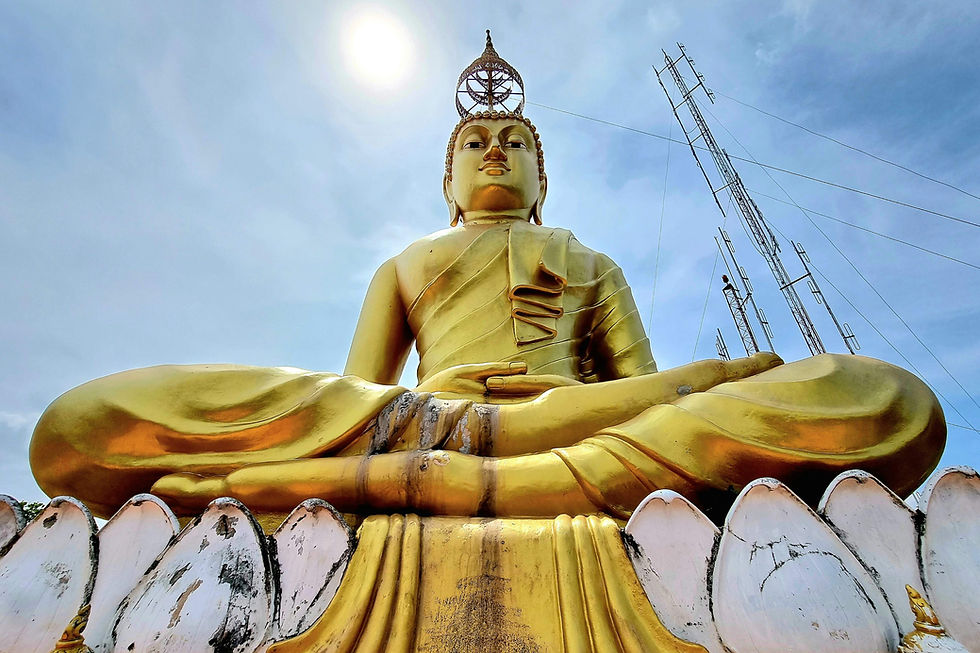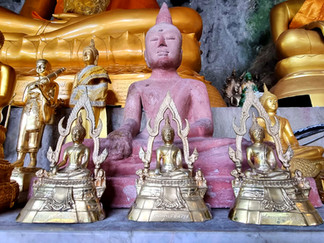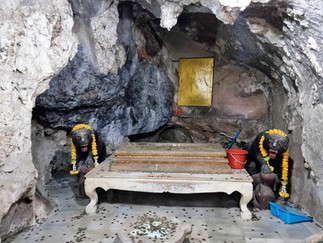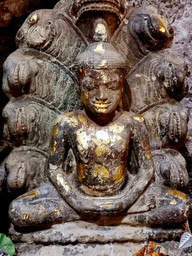Tiger Cave Temple - Wat Tham Suea
- Shannon
- Oct 10
- 4 min read
Krabi’s Spiritual Mountain Sanctuary
This relatively modern monastery and temple complex was established in 1975 by a Vipassana Abbot named Ajahn Jamnian, who was in search of a secluded and tranquil place for deep meditation practice. Drawn by the natural serenity of the area, he found this remote forested location ideal. According to local accounts, after spotting tigers roaming through the surrounding jungle and discovering tiger paw prints on the cave walls, the temple earned its distinctive name, forever linking it to the wild beauty of its environment.

The giant golden Buddha on the summit looks out over the limestone karsts in the Kiriwong Valley to the Andaman Sea
The term Vipassana translates to “insight” or “seeing things as they really are.” It is a form of meditation rooted in Theravāda Buddhism, particularly practiced by modern Burmese traditions. This technique involves careful observation of the mind and body through sustained mindfulness of thoughts, emotions and physical sensations, with the goal of gaining a profound understanding of the true nature of existence. Today, Wat Tham Sua is home to approximately 30 to 40 Buddhist monks who reside on the temple grounds. Among them, about eight monks live in the caves nestled in the foothills on the northern side of the complex, embracing an even more solitary and contemplative lifestyle.

Archaeological findings suggest that this area was inhabited during both prehistoric and early historical periods, with compelling evidence of human and animal activity spread throughout the extensive cave network. Among the discoveries are human skeletons, intricately decorated skulls, stone tools, pottery shards and a unique mold believed to have been used for creating Buddha footprints. Although these particular items have yet to undergo carbon dating, similar research conducted in nearby caves indicates human presence dating back as far as 30000 years. The mold, based on stylistic features, is thought to originate from the Ayutthaya period, roughly 700 years ago, adding a layer of historical depth to the spiritual significance of the site.
The most well known and frequently written about feature of this temple complex is the observation deck perched at the summit, marking the beginning of the Khao Phanom Mountain range. Officially named the Tham Sua Khao Ao Look Thanoo Enlightenment Centre, this viewpoint offers breathtaking panoramic vistas of the surrounding landscape. Reaching it however, is no small feat, visitors must conquer 1260 steep, nearly vertical steps to ascend to the top, making the journey as much a test of physical endurance as it is a spiritual experience.
The exceedingly steep and uneven stairs ascending to the summit are BRUTAL
At a height of 309 metres above sea level, the summit offers a breathtaking 360 degree panorama that stretches across the green expanse of the Kiriwong Valley, the distant shimmer of the Andaman Sea and the low lying sprawl of Krabi Town. It’s a view that rewards every aching step of the steep ascent. At the top, visitors are greeted not just by the sweeping views but by a collection of sacred structures. Several statues of the Buddha sit peacefully, including a large golden Buddha that overlooks the valley below, symbolising watchful wisdom and compassion. A golden chedi adds a sense of grandeur and sacredness to the site. There's also a small yet beautifully adorned shrine where devotees and visitors alike can pause to offer incense, meditate or simply take in the spiritual atmosphere of the mountain’s peak. The combination of natural beauty and religious iconography creates an atmosphere that is both awe inspiring and deeply tranquil.

There is also a revered imprint of the Buddha’s foot, known as a Buddhapada. These sacred footprints hold deep symbolic meaning, representing the Buddha’s earthly presence during his lifetime and his subsequent detachment from the material world after attaining nirvana. Rather than depicting the Buddha as a deity, the Buddhapada serve as a powerful reminder that he was a real human being, someone who walked the earth, experienced life and achieved enlightenment through his own efforts. This grounding of the transcendent makes the Buddha’s teachings feel accessible and relatable to all who seek them, emphasising that enlightenment is within reach for anyone willing to follow the path. The imprint at the summit is not just a physical relic but a spiritual symbol inspiring humility, devotion and hope.
Inside the cave temple, visitors will find an atmospheric interior filled with spiritual symbolism and devotional artefacts. The dimly lit chambers house a number of ornate shrines dedicated to the Buddha, surrounded by flickering candles and the scent of incense. Life sized tiger statues pay homage to the temple’s namesake and the legends tied to the area, serving as protectors of the sacred space. Scattered throughout the cave are sacred relics, religious icons and intricately carved Buddha images embedded into the rock walls. The cave network isn’t just a place of worship, it’s a living sanctuary. Monks reside within its cool, shadowy depths, using the quiet isolation for meditation, chanting and daily monastic routines. Small, simple living quarters blend seamlessly into the natural rock formations and visitors may occasionally glimpse robed figures walking silently between shrines or seated in deep contemplation. The atmosphere is one of reverence and calm, where centuries of spiritual practice echo through the stone corridors.

🗺️ Location
35 Tambon Krabi Noi, Amphoe Mueang Krabi, Krabi Province, Thailand
🚆 How to get there
The Tiger Cave Temple is located a 15 minute drive north east of Krabi Town bus terminal, in the Tambon Krabi Noi area of Krabi province. You can get there by hailing a tuk tuk or songtheaw or by taxi using the Grab app. It is about 30 minutes drive from Ao Nang Beach. Many day tours will include a visit here in the itinerary.
⭐ Attraction Info
TheTiger Cave Temple - Wat Tham Suea is open daily between 5am - 6pm. Entrance to Wat Tham Suea is free however you are encouraged to give a 40THB donation towards the temple's maintenance. If you have mobility issues or a heart condition, I would recommend NOT going up to the summit. If you do, head out in the morning or later in the afternoon to avoid the heat. Take plenty of water, take your time and enjoy the view. Allow 2 - 3 hours to visit this site.
Thanks for reading about the Tiger Cave Temple - Wat Tham Suea. Check out more awesome destinations here!












































